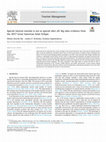Papers by Svetlana Stepchenkova
As our International Journal of Tourism Cities approaches its third "birthday", we asked the memb... more As our International Journal of Tourism Cities approaches its third "birthday", we asked the members of IJTC's editorial advisory board to share their views on trends likely to affect the future of urban tourism over the next ten years and the role of the International Journal of Tourism Cities in shaping this future. Their contributions, shown below, are full of fascinating insights.

Information and Communication Technologies in Tourism 2021, 2021
The purpose of the study is to investigate whether cultural differences are reflected in how dest... more The purpose of the study is to investigate whether cultural differences are reflected in how destinations present themselves online by performing hyperlink network analysis of their official DMOs websites. The study examines whether variance in online presentation can be explained using well established theories on culture. To this end, hyperlink data were collected from three official tourism websites: Korea Tourism Organization (KTO) of South Korea, Brand USA of United States, and German National Tourist Board (GNTB) of Germany. The results show that the three hyperlink networks exhibit differences in size and structural properties. The information network of KTO tends to reflect collectivism, while those of Brand USA and GNTB reflect individualism. Blockmodeling analysis provides the grounds for further statistical approach.

Tourism Management, 2021
This study developed an authenticity orientation scale to measure the attitudes of tourists towar... more This study developed an authenticity orientation scale to measure the attitudes of tourists toward object-based authenticity of cultural and historic artifacts, attractions, and tourist sites. The attitudes underlying the scale have been described in authenticity literature as a continuum of attitude orientations ranging from predominantly realist to constructivist to postmodernist. To numerically distinguish tourists with respect to their attitudes, the researchers employ Thurstone's method of equally appearing intervals (Thurstone, L.L. 1928. Attitudes can be measured. The American Journal of Sociology, 26, 249-269) with subsequent validation. The newly developed scale has undergone rigorous construction and testing procedure. Its predictive validity was ensured through hypothesis testing using an online survey with a panel of 514 American tourists. The theoretical significance of the study lies in understanding the mechanism of "authentication" of various artifacts, attractions, and tourist sites by visitors. Implications for tourism management and directions for further research are discussed.

This study investigates how bilateral political tensions between China and South Korea influence ... more This study investigates how bilateral political tensions between China and South Korea influence the image of a destination country, South Korea, and desire of tourists to visit it. In the past decades, Chinese tourists held relatively positive images towards South Korea in aspects of Korean wave, safety, cleanliness, and friendly people, but the deployment of the Terminal High Altitude Area Defense system in South Korea greatly changed perceived images towards South Korea. Given the need to quantify qualitative data of destination image and identify hidden interrelationships of sparse destination images. This study investigates the diversity of image associations that Chinese tourists hold towards South Korea in the context of current conflict and utilizes network analysis to identify the core-periphery structures of the image. Further, the study explores the impact of the network clusters on Chinese tourists’ overall attitude toward South Korea and intention to visit South Korea

Information and Communication Technologies in Tourism 2021, 2020
Tourism and hospitality crises that are extensively discussed online are damaging to organization... more Tourism and hospitality crises that are extensively discussed online are damaging to organizational image and reputation; therefore, choosing effective response strategies is of paramount importance for service providers. The online discussions data from six hospitality and tourism related crises were used to test which crisis and media coverage characteristics significantly affected the public’s emotional and behavioral reactions to crises. With reference to the attribution theory and the situational crisis communication theory, this study identified the potentially influential crisis characteristics, hypothesized their relationship with variables describing consumer reactions to crises, and then tested those relationships in a series of ANOVA and hierarchical regression analyses. Results indicated that the locus of control, crisis stability, attribution of organizational responsibility, and organizational response strategy affected the public’s cognitive and emotional responses to...

Tourism in general, and its proceeds in particular, is a powerful force in global and regional we... more Tourism in general, and its proceeds in particular, is a powerful force in global and regional wealth distribution and economic development, causing destinations to engage in branding and marketing battles for tourists. In 2011, the United States launched a new initiative, Brand USA, the first centralized effort to promote the country overseas and capitalize on the globally increasing travel and tourism. The Brand USA's message is "fresh, welcoming and inclusive" highlighting "boundless possibilities of the United States" (Montgomery 2011). However, with the U.S. being both a supreme economic power and a mighty geopolitical player, the Brand USA marketers cannot expect that their focused, carefully crafted messages will not be "diluted" by multitudes of information streams about the U.S. that reach actual and potential tourists from various sources (Stepchenkova and Li 2014). These informational fragments about the U.S. government, people, international politics, and bilateral relationships with the source market country contribute to perceptions of the U.S. as a country and, quite possibly, affect tourists' perceptions of the U.S. as a vacation destination. In business and marketing literature, the "country-of-origin image-product image" research has a long history (Dinnie 2004). The general consensus is that the better the country image, the more likely the product of that country will be popular with consumers. Avoidance of foreign products may be driven by the feelings of animosity stemming from economic or political conflict between countries (Amine 2008; Klein et al. 1998; Klein 2002), as well as feelings of national pride and ethnocentrism (Verlegh 2007). Destinations, however, are remarkably more complex products than fast-moving consumer goods and are characterized by a high level of consumer involvement at all stages of product consumption (e.g., Bigne et al. 2001; Chen and Tsai 2007), destination selection included. While studies indicate that, when the product is tourism, political instability at destination affects tourism (Seddighi et al. 2001), research on the relationships among the country image, tourism destination image, and willingness to buy the destination product has emerged in tourism literature relatively recently (Elliot et al. 2011; Roth and Diamantopoulos 2009). Tourism literature on buying destination product in a situation of conflict and animosity is also scarce, with a notable exception of Chen et al. (2012). The purpose of this study is to examine attractiveness of global tourism brands when the country of the brand and the country of the source market are in a situation of political and economic conflict. The study is set in the U.S.-Russia context, where the U.S. is the vacation destination, and Russia is the tourism generated region. The relationships between the U.S. and Russia have been steadily deteriorating over the past two years. The amount of negative coverage of the U.S. in Russian media and social networks has been noticeably increasing, starting with the Magnitsky Act and the Dima Yakovlev Law in 2012 and culminating over the events of 2013-2014 in Ukraine, annexation of the Crimea, and the military conflict in Donbass. Media and social networks, as well as rhetoric of Russian official agencies, reflect the growing levels of national pride and animosity towards the U.S. To investigate whether these attitudes affect the desire of Russian tourists-a lucrative market in terms of tourist expenditures-to vacation in the U.S. is a timely research focus. Specifically, the study investigates the effects of the country image, tourism destination image, animosity, and ethnocentrism on the desire to buy destination product, that is, visit the destination, in the context of the current U.S.-Russia bilateral relationship. THEORETICAL BACKGROUND Country-of-origin image influences consumers' evaluation of the product, risk, likelihood of purchase, and other mediating variables; the nature and strength of those effects depend on a number of product-related (e.g., product category) and consumer-related (e.g., demographics) factors (Liefeld 1993). Papadopolous et al. (1990) were among the first researchers to use distinct country image measures to model the relationships between country beliefs, product beliefs, familiarity, product evaluations, and willingness to buy. While the majority of country-of-origin effects studies used tangible products like

Journal of Destination Marketing & Management, 2020
This study investigates how bilateral political tensions influence tourists' perceptions of a str... more This study investigates how bilateral political tensions influence tourists' perceptions of a strong national brand, as well as their attitudes toward and intent to visit the country, using network and decision-tree regression analyses. The context of the study is the conflict between South Korea and its primary tourist market, China, over the deployment of the Terminal High Altitude Area Defense (THAAD) system (July 2016-December 2017). From April to June of 2018, the study collected the most salient images of Chinese tourists associated with South Korea and organized them in the core-periphery network of South Korea's image. It was found that while the overall image was positive, the core cluster contained conflict-specific negative images. With respect to attitude and visit intention, images that differentiated among tourists belonged to the peripheral clusters, and not to the core cluster. Practical implications of the study findings are suggested.
Tourism and Hospitality, 2020
It is my privilege to serve as founding editor of our new journal, Tourism and Hospitality, and m... more It is my privilege to serve as founding editor of our new journal, Tourism and Hospitality, and my pleasure to welcome you to its pages [...]

Tourism Management, 2020
This study puts to empirical test a major typology in the tourism literature, mass versus special... more This study puts to empirical test a major typology in the tourism literature, mass versus special interest tourism (SIT), as the once-distinctive boundary between the two has become blurry in modern tourism scholarship. We utilize 41,747 geo-located Instagram photos pertaining to the 2017 Great American Solar Eclipse and Big Data analytics to distinguish tourists based on their choice of observational destinations and spatial movement patterns. Two types of tourists are identified: opportunists and hardcore. The motivational profile of those tourists is validated with the external data through hypothesis testing and compared with and contrasted against existing motivation-based tourist typologies. The main conclusion is that large share of tourists involved in what is traditionally understood as SIT activities exhibit behavior and profile characteristic of mass tourists seeking novelty but conscious about risks and comforts. Practical implications regarding the potential of rural and urban destinations for developing SIT tourism are also discussed.

Journal of Travel Research, 2019
This study expands the empirical evidence amassed to date concerning tourists’ decision-making pr... more This study expands the empirical evidence amassed to date concerning tourists’ decision-making processes in a situation of conflict between a country of origin’s market and country of destination. It uses the constructs of animosity, national attachment, consumer ethnocentrism, country image, and perceptions of the state of bilateral relations in order to examine three intent to visit scenarios. To obtain the robust results, the study uses two methods of analysis from distinctly different repertoires of techniques, such as traditional statistical and data-mining approaches, and applies them to each scenario. The results consistently indicate a high level of influence of general animosity and ethnocentric tendencies in addition to country image and bilateral relation variables in tourists’ decision making. The situational context of the study is the conflict between China, the country of origin, and South Korea, the country of destination, over the Terminal High Altitude Area Defense...

International Journal of Tourism Cities, 2019
Purpose The purpose of this paper is to examine whether events such as acts of terrorism, politic... more Purpose The purpose of this paper is to examine whether events such as acts of terrorism, political and social turmoil, military conflicts, epidemics, and similar influence preferences of Russian tourists for international and domestic travel (DT) and the role of psychographic and demographic factors in this process. Design/methodology/approach The study is a survey of 139 international tourists from a large Russian city. Variables representing the influence of instability in the world on selecting international vacations (unstable world, UW) and the willingness to turn to DT instead (domestic tourism, DT) were operationalized. The study operationalized the constructs of national attachment and consumer ethnocentrism and then converted them into manifest variables, NAT and CET. Hierarchical linear regression and logistic regression were conducted to investigate the relationship between UW and DT variables and personal factors. Supporting ANOVA and χ2 tests were conducted to further ...
Current Issues in Tourism, 2019
This study used the value-attitude-behaviour model to test the hypothesized impacts of altruistic... more This study used the value-attitude-behaviour model to test the hypothesized impacts of altruistic values and attitudes on environmentally responsible behaviour and destination loyalty. The study uses tourists' environmental knowledge as a moderator in the proposed relationship. The participants were South Korean tourists visiting Jeju Island, a premier eco-destination that is experiencing a large influx of tourists. The results indicate the important role of altruistic values, attitudes, and environmental knowledge within the context of nature-based tourism. The study provides implications for managing a nature-based destination in a sustainable manner.
Tourism Management Perspectives, 2018
Destination branding has grown as a powerful marketing tool that helps a tourist destination dist... more Destination branding has grown as a powerful marketing tool that helps a tourist destination distinguish itself from its competitors. This study showcases the branding process of a local attraction in Florida, USA, from the theoretical perspective of value co-creation. The attraction's owners, managers, tourism researchers, and, most importantly, actual and potential visitors were involved in this co-creative re-branding process. Beyond the immediate value of the study outcomes specific to this particular attraction, the case study offers a feasible model of co-creative destination branding which actively involves the perspectives of destination consumers. The study also demonstrates and offers some innovative methodological approaches in data collection and analysis that may assist decision-making within the co-creation research framework.

PLOS ONE, 2018
This paper uses text data mining to identify long-term developments in tourism academic research ... more This paper uses text data mining to identify long-term developments in tourism academic research from the perspectives of thematic focus, geography, and gender of tourism authorship. Abstracts of papers published in the period of 1970-2017 in high-ranking tourist journals were extracted from the Scopus database and served as data source for the analysis. Fourteen subject areas were identified using the Latent Dirichlet Allocation (LDA) text mining approach. LDA integrated with GIS information allowed to obtain geography distribution and trends of scholarly output, while probabilistic methods of gender identification based on social network data mining were used to track gender dynamics with sufficient confidence. The findings indicate that, while all 14 topics have been prominent from the inception of tourism studies to the present day, the geography of scholarship has notably expanded and the share of female authorship has increased through time and currently almost equals that of male authorship.

Journal of Travel Research, 2017
Interest in applying Big Data to tourism is increasing, and automated sentiment analysis has been... more Interest in applying Big Data to tourism is increasing, and automated sentiment analysis has been used to extract public opinion from various sources. This article evaluates the suitability of different types of automated classifiers for applications typical in tourism, hospitality, and marketing studies by comparing their performance to that of human raters. While the commonly used performance indices suggest that on easier-to-classify data sets machine learning methods demonstrate performance comparable to that by human raters, other performance measures such as Cohen’s kappa show that the results of machine learning are still inferior to manual processing. On more difficult and noisy data sets, automated analysis has poorer performance than human raters. The article discusses issues pertinent to selection of appropriate sentiment analysis software and offers a word of caution against using automated classifiers uncritically.
Services in Russia and abroad, 2017

Journal of Travel & Tourism Marketing, 2017
ABSTRACT This study examines the attractiveness of destination tourism offerings when the destina... more ABSTRACT This study examines the attractiveness of destination tourism offerings when the destination country and the source market country are engaged in ongoing political and economic conflict. The study is set in the Russia–United States (US) context, where Russia is the tourism-generating region and the US are the vacation destination. Specifically, the study investigates how the desire of Russian tourists to vacation in the US is affected by perceptions of the US as a country and as a vacation destination, animosity toward the US, and Russian touristsʼ level of national attachment and ethnocentric tendencies. The study found that country image, destination image, and general animosity have a direct effect on intention to visit. The effects of consumer ethnocentrism and national situational animosity on intention to visit are mediated by destination image and country image respectively.

Journal of Destination Marketing & Management, 2017
Destination personality is an essential element of destination brands and closely connected to vi... more Destination personality is an essential element of destination brands and closely connected to visitors' experiences and emotions at the destination. This study investigates the reconstruction of destination personality through tourists' written accounts in the situational context of Jeju Island, South Korea. Guided by the brand personality literature and a content analysis of tourists' description of their experiences on travel blogs, the study identifies a set of traits that describe the personality of Jeju Island and further compares personality perceptions between tourists from Eastern and Western markets. The results indicate that tourists' written accounts provide rich information to understand visitors' experiences and an emotional connection to the destination through which destination personality manifests itself. The findings also indicate that destination personality perceptions may vary according to tourists' cultural backgrounds. The results of the study may assist DMOs in developing marketing strategies that are adaptive to cultural differences among their origin markets.










Uploads
Papers by Svetlana Stepchenkova